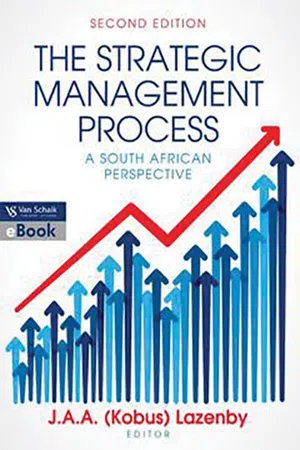Technology & Engineering
McKinsey 7S Framework
The McKinsey 7S Framework is a management model that identifies seven internal factors of an organization that must be aligned for it to be successful. These factors include strategy, structure, systems, shared values, skills, style, and staff. The framework is often used to assess and improve organizational effectiveness and to facilitate change management.
Written by Perlego with AI-assistance
Related key terms
Related key terms
1 of 4
Related key terms
1 of 3
3 Key excerpts on "McKinsey 7S Framework"
- eBook - ePub
Strategic management process 2, The
A South African perspective
- Lazenby, K(Authors)
- 2018(Publication Date)
- Van Schaik Publishers(Publisher)
This model was developed in the early 1980s by Tom Peters and Robert Waterman, two consultants working at the McKinsey & Company consulting firm. The basic premise of the model is that there are seven internal aspects of an organisation that need to be aligned if the organisation is to be successful. This model can be used in a wide variety of situations where an alignment perspective is useful in improving the performance of the organisation and when determining how best to implement the strategy. The McKinsey 7S model involves seven interdependent factors, which can be categorised as either “hard” or “soft” elements. The “hard” elements are strategy, structure and systems, and management of these can directly influence the organisational design, the reporting lines, formal processes and the IT systems. The “soft” elements are shared values, skills, style and staff. They are less tangible and more influenced by culture. However, they are as important as the hard elements if the organisation is going to be successful.Although there is not really a design sequence in this model, the starting point is the strategy. Strategy drives organisational structure and must fit the culture in the organisation. Culture is based on the shared values and is especially influenced by the style of leadership. The systems will be determined through, and influenced by, the organisation’s structure. Structure and systems will define what staff and skills are required. The seven components can thus be described very briefly as follows:- Strategy: the plan devised to maintain and build competitive advantage
- Structure: indicates the way the organisation is structured and who reports to whom
- Systems: involve the daily activities and procedures (e.g. IT systems) that staff members engage in to get the job done 366
- eBook - ePub
Business Analysis Techniques
123 essential tools for success
- James Cadle, Debra Paul, Jonathan Hunsley, Adrian Reed, David Beckham, Paul Turner(Authors)
- 2021(Publication Date)
- BCS, The Chartered Institute for IT(Publisher)
This element concerns the business actors employed within the organisation or business area. It considers the ways in which their performance is developed, measured and assessed. Skills This element concerns the skills possessed by the business actors employed within the organisation or business area. The organisational capabilities may also be considered within this element.Using the McKinsey 7SThe McKinsey 7S Framework may be used in many different contexts. For example, to explore the issues with a business situation, identify where changes need to be made in order to achieve a target state or analyse how a business strategy may be executed.There are two key aspects of the McKinsey model: the 7S elements themselves; and the lines that connect the elements.The shared values are shown at the centre of the 7S framework because they connect and drive all of the other elements. They should be clearly understood and communicated to everyone working within the organisation or business area. There may be situations where some values are not shared by all of the business actors; it is necessary to uncover and resolve these differences of view before moving to a new business system.Analysing each of the elements individually offers opportunities to identify where there are gaps. For example, if the shared values are unclear, they should be identified and agreed; where the strategy of the organisation or business area has not been defined, there is a need for strategy analysis and definition; where the systems required to deliver the strategy are not in place, they should be procured or developed.The connections between the individual elements should also be analysed to ensure that there is alignment and consistency. There are likely to be issues when deploying business changes if there is misalignment between the elements. For example, if the structure has few levels of management but the management style requires high levels of control, managers may have large teams and insufficient time to direct the work and this may result in high uncertainty and low productivity. - eBook - ePub
Entrepreneurship and Innovation Education
Frameworks and Tools
- Marcos Lima(Author)
- 2020(Publication Date)
- Wiley-ISTE(Publisher)
If a business student were asked to describe a complex organization, such as Apple Inc., he or she might be tempted to talk about well-known, trivial aspects of that iconic company, such as its location in California, its product line, its brand reputation and its charismatic founder and historic CEO Steve Jobs. Usually, though, students quickly run out of elements to describe Apple or any other organization, even ones they are very much familiar with, like their own business school or the firm where they are doing their internship. The reason for such lack of depth is that the human mind tends to focus on only a few aspects of any problem at any given time. Hence, frameworks play such an important role in business learning. As we have seen throughout this book, a framework can be simply defined as a “checklist” for thinking (Lima and Fabiani 2014).Consider, for example, organizational analysis frameworks. If we break down the above question with the help of a classic framework, such as McKinsey’s 7S model (structure, strategy, systems, staff, skills, style and shared values), a student will be able to ask more specific questions, such as “What is Apple’s strategy in the smartphone market?” or “How does Apple use its structure to incentivize creativity among its engineers?” or “What are some of Apple’s staff recruiting criteria?” These framework-based questions are a meaningful guide to understanding the complexity of organizations as they grow.6.1. An overview of management systems
Before discussing how innovative organizations can use the 7S framework for knowledge management, it is convenient to recall the basic definitions of management in general and innovation management in particular. A question that even advanced students sometimes struggle to thoroughly answer is, how can we define any type of management process – project management, knowledge management, innovation management etc.? While some of their answers capture some of the aspects of management, students rarely have a systemic view of the management process. Based on the classic PDCA cycle or “Deming Wheel”, Figure 6.1 illustrates the key elements of a simple management system.The PDCA principles are nothing new. In fact, they can be traced back all the way to the creation of the Scientific Method by Francis Bacon in the 17th Century, whose “hypothesize–experiment–evaluate” process is very similar. What makes management a particular “science” is that it consists of planning, allocating and controlling a very particular set of resources
Index pages curate the most relevant extracts from our library of academic textbooks. They’ve been created using an in-house natural language model (NLM), each adding context and meaning to key research topics.
Explore more topic indexes
Explore more topic indexes
1 of 6
Explore more topic indexes
1 of 4


